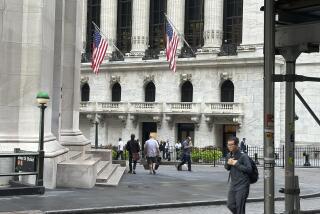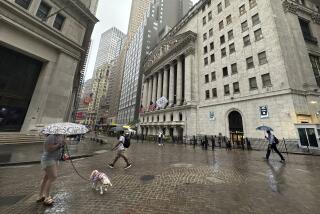1st Sign of Autumn on Wall Street: Rumors of a Crash
- Share via
With Tuesday’s 67-point plunge in the Dow industrials, the chant of “Remember 1987!” is likely to be joined by more panicky voices on Wall Street.
For die-hard stock market bears, the comparisons between today’s market and that of October, 1987--host to the greatest stock crash of the modern era--are piling up at a frightening pace:
* Interest rates continue to rise, just as they did in the summer and early autumn of 1987. On Tuesday, the 30-year Treasury bond yield closed at 7.77%, its highest in more than two years.
* The nation’s merchandise trade deficit is ballooning at a pace last seen in 1987, thanks to Americans’ ravenous appetite for imports. The deficit for July, reported Tuesday, was the second-worst monthly figure ever and was the catalyst for the stock market’s dive.
Investors’ fear is that an unchecked deficit will further devalue the dollar (because we’re sending too many of them abroad), in turn spurring the Federal Reserve to drive interest rates even higher in an attempt to defend the buck.
* Gold is surging again, suggesting that savvy investors are running for cover. Gold futures for October jumped $3.60 to $394.10 an ounce on the Comex on Tuesday, the highest price in 13 months. In 1987, gold rocketed from $400 to about $480 ahead of the October stock market crash.
* Traders are increasingly being accused of manipulating the market for short-term gain. Today, the culprits are using stock options to create brief but tradable market “waves.” In 1987, investors using “portfolio insurance” tactics sparked wild volatility with stock index futures.
*
The bears’ case today is that the stock market--or at least the Dow industrial average--has wrongly chosen to quickly overcome most of the bad news that has come down the pike this year, just as stocks drove higher for most of 1987 in the face of withering fundamentals. And as in 1987, the bears say, when investors today finally wake up to reality, the result will be carnage.
What about the healthy economy and its bullish implications for corporate profits? What about the boom in takeover activity? Both of those elements were present in 1987 as well, the bears note. But that didn’t stop the Dow from plummeting from 2,641.00 in early-October of that year to 1,738.74 at the crash bottom on Oct. 19.
Perhaps most worrisome today is that one of the main ingredients of the poison brew that killed the market in 1987--rising German interest rates--could be this year’s October surprise. With Europe’s economic recovery in full swing, and central banks in Italy, Sweden and Britain having recently boosted short-term rates, the German Bundesbank probably won’t be far behind.
The problem with predicting another market crash, however, is that so many people are already steeled for one. Yet rarely do crashes arrive by appointment.
Robert Nurock, a veteran analyst in Santa Fe, N.M., notes that many big stock investors have already raised their cash reserves this year, expecting the worst. What’s more, most market newsletter writers polled by Investors Intelligence are already either outright bearish or expect a market “correction.” In contrast, bullishness was rampant nearly up to Crash Day in 1987.
A.C. Moore, money manager at SBCM/Argus in Santa Barbara, points out what may be the most important difference between 1987 and today: While interest rates are rising, they still are far below what investors had to contend with in ’87. Then, rates got high enough to threaten recession. That’s not yet the case today.
“Interest rates aren’t near levels that produce strain on the financial system,” Moore contends, while stocks’ valuations are below 1987 levels. Thus, most investors (big and small) can’t find a good reason to abandon the market wholesale.
Still, that doesn’t preclude another short-term slump in stocks, as investors turn jumpy. The market took a 10% hit in winter as interest rates began to rise, bounced back, dove again in June, then rallied back in August. The upshot is that buying on pullbacks, which has worked well since 1987, has again been a winning formula in ’94.
The bear case, of course, is that at some point buying into relatively modest declines won’t work, because a full-fledged bear market will be upon us--taking prices down 25% or more in a hurry. Bernard Schaeffer, money manager at the Investment Research Institute in Cincinnati, doesn’t doubt that the bears will be right eventually. But before that can happen, the similarities between today’s backdrop and that of ’87 will have to grow much more intense, Schaeffer says. It’s still too early in the game, he argues.
Deja Vu?
Though stock prices are much higher today than before the October, 1987, market crash, interest rates and other influencing factors are much less onerous.
Oct. ’87 Index/investment peak Now 3-month T-bill yield 7.39% 4.73% 30-year T-bond yield 10.22% 7.77% Gold (ounce) $481.00 $394.10 Dow industrials 2,641.00 3,869.09 S&P; 500 328.08 463.36 S&P; 500 price-to-earnings* 16 15
* 1987 figure based on actual 1987 operating earnings; current figure based on estimated 1994 operating earnings
More to Read
Inside the business of entertainment
The Wide Shot brings you news, analysis and insights on everything from streaming wars to production — and what it all means for the future.
You may occasionally receive promotional content from the Los Angeles Times.










